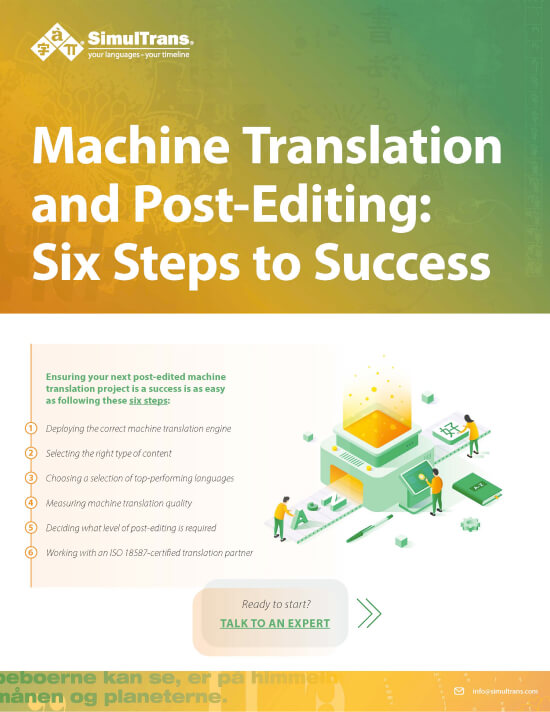


Advanced AI translation services
Complete AI translation and post-editing services
Companies face the challenge of translating large volumes of content efficiently and at speed for their international customers.
From training manuals to knowledge bases, eLearning videos to user-generated content (UGC), and frequently asked questions (FAQ), every piece of content demands efficient translation.
SimulTrans leverages advanced automated translation tools to expedite timelines, maintain quality, and significantly reduce project costs.
Connectors to your CMS automate the translation process, while customized workflows allow translated content to be post-edited to make it culturally relevant to international audiences.
SimulTrans offers:
- AI translation: The engine translates the text without any human involvement. Recommended only for gisting.
- AI translation and post-editing: The engine translates the text, and linguists optimize it as they post-edit for instant and continuous improvement. Recommended for ongoing projects.
- Linguistic validation: Our subject-matter experts review and edit the machine-translated content you provide to add the human touch.
How it works


How it works
- To get your project translated, simply share your content, receive a free quote, and approve it.
- SimulTrans' engineers use AI machine translation to translate your content into your requested languages.
- SimulTrans’ project managers select the best subject-matter expert linguists to post-edit the content for terminology accuracy and linguistic style.
- SimulTrans incorporates the post-edited translations into their original source formats (InDesign, Word, SCORM) or imports them back into your system.
- When you need updates or have more content to translate, SimulTrans uses translation memory to ensure you don’t pay to translate the same text twice.
Your partner for AI translation services
Thanks to our expertise with a variety of artificial intelligence translation technology, computer-assisted translation (CAT) tools, and file formats, we can parse text for translation, integrate advanced AI translation into a traditional translation memory workflow for optimal leverage, post-edit the output, and provide translated files you can immediately use.
SimulTrans is ISO 18587:2017 certified, a standard specifically focused on post-editing of machine-translated content.
Benefits of partnering with SimulTrans:
- There’s never an added cost to you for the tools and technology we use to translate your materials.
- We’ll always suggest the most cost-effective solution for your needs.
- Translation memory saves time and money by reducing unnecessary rework while maintaining consistency.
- The SimulTracker portal keeps every project organized and improves collaboration between teams.
- We connect our systems to yours to automate ongoing translation projects, accelerating work and reducing admin needs.

Machine Translation and Post-Editing: Six Steps to Success
More insights

Improve AI Translations with Human Review

Why AI Alone Can’t Translate All Your Content Accurately

Why Automated Language Quality Assessment Needs Human Expertise
Frequently asked questions
What is artificial intelligence language translation?
Advanced artificial intelligence (AI) translation is the process of using artificial intelligence (AI) engines to automatically translate content from one language to another, without human input. Compared to traditional machine translation, it provides a higher level of accuracy, it is easy to implement and customize, and results in a more cost-efficient process.
Which languages are supported by AI translation?
The most advanced engines are compatible with more than 100 languages, from Albanian to Zulu. They are also able to handle source content in a limited set of languages, besides English.
Is advanced AI the same as neural machine translation?
Artificial intelligence is a fundamental component of neural machine translation. It empowers machines to interpret and convert text and audio from one language to another using natural language processing, relying on advanced algorithms and data-driven models. The AI translation systems further incorporate cutting-edge neural networks and deep learning methodologies to augment their understanding of context and language structure, ensuring translation accuracy and fluency.
How much does AI language translation cost?
Costs for translating your content using advanced AI translation vary by language. Typically, costs are associated with preparing the content for machine translation, integrating it with the machine translation engine and generating the machine-translated content. Also, there are costs related to post-editing the machine-translated words. These are charged per word and represent a percentage of the average human translation cost. To get a better idea, get a quote.
What file format works well for machine translation?
Machine translation can handle any type of file if provided in a localization-friendly format. These include desktop files from popular apps like Office and Adobe Creative; tag-based files (XML, HTML, XLIFF); and key-value software files (JSON, YAML, Strings, PO, among others). SimulTrans can also handle virtually any other localizable file format by pre- or post-processing them; contact us for details.
What type of content works well for AI translation?
AI translation works well for localizing most content types, although it is not recommended for highly creative marketing copy. This is because copywriting often relies on cultural context to convey its message. Types of content better suited to machine translation include documentation, communications, descriptive text, user interface, help and knowledge bases, and general legal, medical, and multimedia content. Check out if your content is suitable for machine translation.
What is post-editing?
Post-editing or MTPE (machine-translation and post-editing) is the process of reviewing and editing machine-translated output to the required quality standards. Post-editing is carried out by professional linguists/post-editors as it requires source and target language proficiency and knowledge of the content being post-edited. Experienced linguists customize and optimize the engine as they post-edit the raw output, systematically providing corrective human feedback for instant and continuous improvement. There are two different types of post-editing: full and light. While light post-editing is a good solution for certain content types, full post-editing is often required.
How long does advanced AI translation take?
SimulTrans can accommodate almost any timeline with AI translation. Applying machine translation to the content does not take long, but if your project requires post-editing, timelines depend on word count, content complexity, and the number of linguists involved. Post-editors can usually handle about 7,000 words per day. Our linguists work simultaneously, so the number of target languages won’t impact your timeline.
How do you measure AI translation quality?
Several automated quality scores or indicators have been traditionally used to provide quality measurements for machine-translation output, like BLEU, TER, or METEOR. Because of the substantial improvement in AI machine translation output, AI-powered features have been recently developed to estimate the quality, based on algorithms that can predict how much post-editing will be required. Human translators can also be used to evaluate the quality by comparing among translations from different engines to decide which one provides the best output for the specific content.
.jpg)

